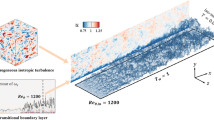Abstract
A model has been proposed for the momentum eddy diffusivity induced by free stream turbulence intensity and integral length scale. The eddy diffusivity model is applied to the stagnation point of a cylinder situated in a uniform crossflow in the presence of free stream turbulence. A numerical solution of the governing momentum and energy equations with the proposed eddy diffusivity model yielded results for the skin friction coefficient and the Nusselt number. The numerical predictions of the present work are compared with experimental data and the agreement between the two is seen to be very good.
Similar content being viewed by others
Abbreviations
- C f :
-
skin friction coefficient τ w/(1/2 ρU 2Г )
- D :
-
diameter of cylinder
- K :
-
thermal conductivity
- L x :
-
integral length scale of free stream turbulence
- L :
-
dimensionless integral length scale defined in equation (17)
- Nu:
-
Nusselt number (hD/k)
- Pr t :
-
turbulent Prandtl number (ε m/ε n)
- q :
-
heat flux rate
- Re:
-
Reynolds number (U Г D/v)
- T :
-
temperature
- Tu:
-
turbulence intensity (u′/u Г)
- u, v :
-
velocity components
- u′ :
-
rms velocity fluctuation
- U e :
-
free stream velocity
- x :
-
coordinate in streamwise direction
- y :
-
coordinate normal to the surface
- z :
-
coordinate in spanwise direction normal to both x and y
- ρ :
-
density
- α :
-
thermal diffusivity
- η :
-
dimensionless distance
- λ :
-
dimensionless roll cell wavelength function
- ε m, ε h :
-
momentum and thermal eddy diffusivities respectively
- τ w :
-
wall shear stress
- w :
-
wall conditions
- ∞:
-
ambient conditions
References
Bayley FJ and Milligan RW The Effect of Free Stream Turbulence upon Heat Transfer to Turbine Blading. AGARD Publication
Dyban EP and Epick EYa (1970) Some Heat Transfer Features in the Air Flow of Intensified Turbulence. Proceedings of the 4th International Heat Transfer Conference, Vol. 11, Paris
Galloway TR (1967) Local and Macroscopic Transport from a 1.5-in Cylinder in a Turbulent Air Stream. AIChE Journal 13:563–570
Galloway TR (1973) Enhancement of Stagnation Flow Heat and Mass Transfer through Interactions of Free Stream Turbulence. AIChE Journal 19:608–617
Kesting J, Maeder PF and Sogin HH (1961) The Influence of Turbulence on the Transfer of Heat to Cylinders near the Stagnation Point. ZAMP 12:115–133
Kestin J and Wood RT (1970) The Mechanism which Causes Free Stream Turbulence to Enhance Stagnation Line Heat and Mass Transfer. Paper No. FC 2.7, Fourth International Heat Transfer Conference, Paris-Versailles
Kestin J and Wood RT (1970) On the Stability of Two-Dimensional Stagnation Flow. Journal of Fluid Mechanics, TRANS ASME 44:461–479
Kestin J and Wood RT (1971) The Influence of Turbulence on Mass Transfer from Cylinders. Journal of Heat Transfer, TRANS ASME, Series C 93:321–327
Lowery GW and Vachon RI (1975) The Effective of Turbulence on Heat Transfer from Heated Cylinders. International Journal of Heat and Mass Transfer 18:1229–1242
Sadeh WZ, Sutera SP and Maeder PF (1970) An Investigation of Vorticity Amplification in Stagnation Flow. ZAMP 21:717–741
Schlichting H (1968) Boundary Layer Theory. New York: McGraw Hill Book Company
Schnautz JA (1958) Effect of Turbulence Intensity on Mass Transfer from Plates, Cylinders and Spheres in Air Streams. PhD thesis, Oregon State College
Smith MC and Kuethe AM (1966) Effects of Turbulence on Laminar Skin Friction and Heat Transfer. Physics of Fluids 9:2337–2344
Sutera SP, Meader PF and Kestin J (1963) On the Sensitivity of Heat Transfer in the Stagnation Boundary Layer to Free Stream Vorticity. Journal of Fluid Mechanics, TRANS ASME 16:497–520
Sutera SP (1965) Vorticity Amplification in Stagnation-Point Flow and Its Effect on Heat Transfer. Journal of Fluid Mechanics, TRANS ASME 21:513–534
Traci RM and Wilcox DC (1975) Free Stream Turbulence Effects on Stagnation Point Heat Transfer. AIAA Journal 13:890–896
Turner AB (1971) Local Heat Transfer Measurements on a Gas Turbine Blade. Journal of Mechanical Engineering Science 13:1–11
Yardi NR and Sukhatme SP (1978) Effects of Turbulence Intensity and Integral Length Scale of a Turbulent Free Stream on Forced Convection Heat Transfer from a Circular Cylinder in Cross Flow. Proceedings of the Sixth International Heat Transfer Conference, pp 347–352
Zapp GM (1950) The Effect of Turbulence on Local Heat Transfer Coefficients around a Cylinder Normal to an Air Stream. MS thesis, Oregon State College.
Author information
Authors and Affiliations
Rights and permissions
About this article
Cite this article
Gorla, R.S.R. Stagnation point heat transfer augmentation due to free stream turbulence. Appl. Sci. Res. 39, 143–153 (1982). https://doi.org/10.1007/BF00457016
Issue Date:
DOI: https://doi.org/10.1007/BF00457016




